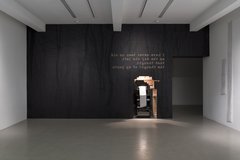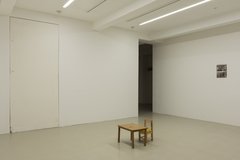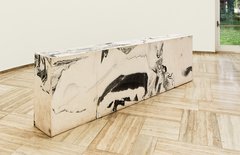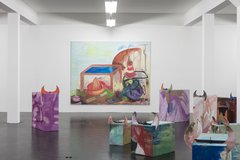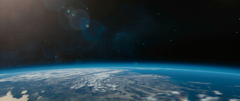The text by Hana Ostan Ožbolt was written for the lecture delivered on the occasion of the exhibition Meta Grgurevič. Impossible Machines at Künstlerhaus, Halle für Kunst & Medien in Graz on 14 February 2020.
The Magical World of Meta Grgurevič
When I first received the invitation to write a text and deliver a lecture on the subject of the artistic practice of Meta Grgurevič (*1979 Ljubljana, lives in Ljubljana), whose exhibition Impossible Machines is currently on display at Künstlerhaus, Halle für Kunst & Medien and at the UGM Maribor Art Gallery, two questions immediately presented themselves. Firstly, how and when did I first intimately encounter Grgurevič's work? Secondly, how familiarized was I with her practice; sufficiently to write about it in-depth?
Five years ago, in 2015, my fellow art history colleagues, my favorite art history professor and I attended Saudade, Grgurevič’s solo exhibition at the Tobačna 001 Cultural Centre in Ljubljana. I remember the exhibition and the subsequent artist talk as if it were yesterday; it may sound exaggerated, but it is true nevertheless. Her work struck me in a way that was then still hard to define; it was an experience. This notion of art as an experience—of it not being solely a material work of art to be perceived and appreciated, but rather a process to be experienced (in its development), is precisely one of the topics I would like to address. While preparing for the lecture, I have discovered I am—despite never having been in close contact with Grgurevič, nor having worked with her—reasonably familiar with her work; I have attended almost all of her solo exhibitions since 2013, as well as most of her group shows in Ljubljana (e.g. the 30th and the 31st Ljubljana Biennial of Graphic Arts, U3 – the 7th Triennial of Contemporary Art in Slovenia). Her artistic practice is fascinating and intriguing, and she is one of the most compelling Slovenian artists at the moment.
This text provided me with the opportunity to conduct a more in-depth reflection on her work. Focusing on some central works in this exhibition and from the last decade, discussing the formal and the content level of her practice and outlining its fundamental considerations, I will attempt to position Grgurevič’s practice in relation to the local and the international art scene.
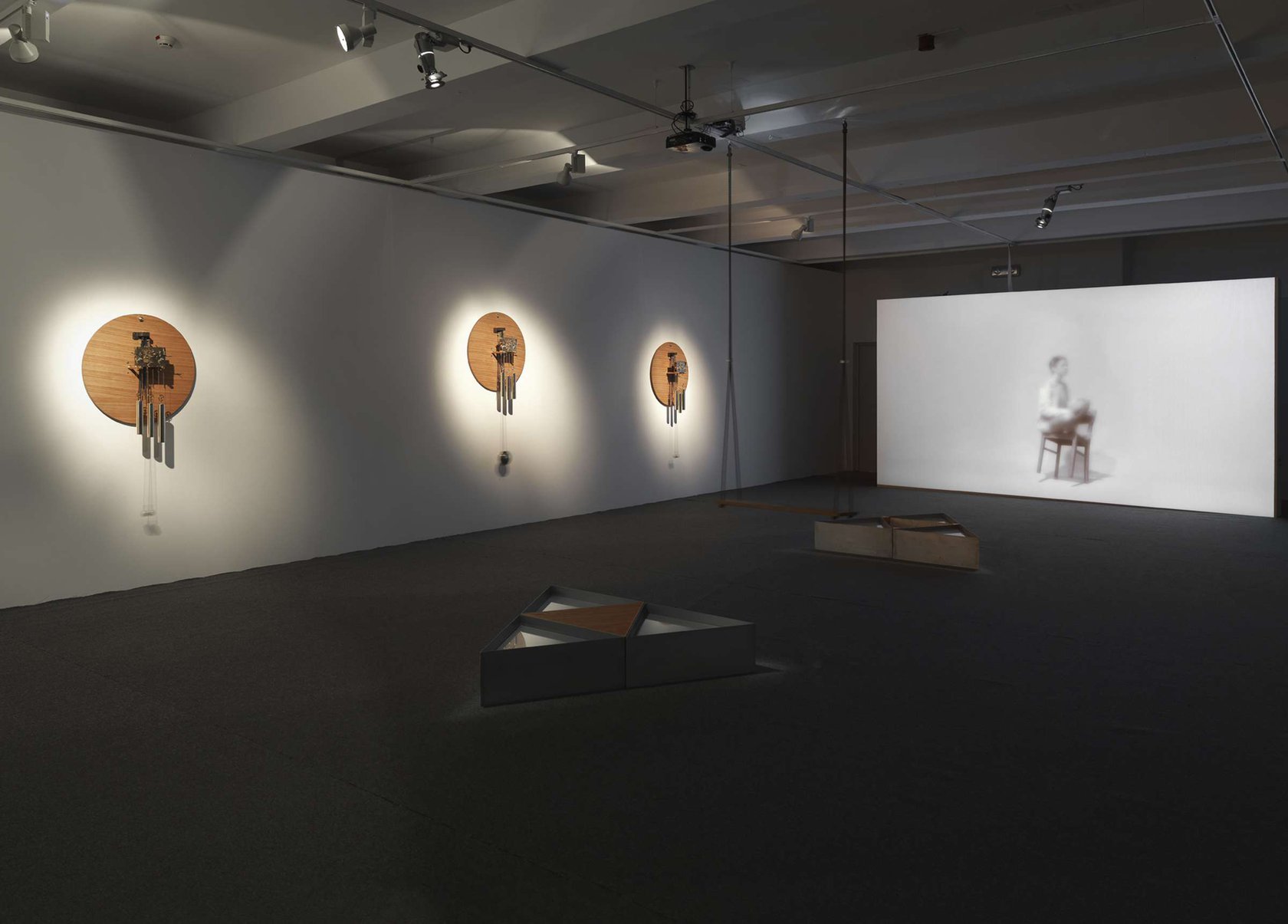
Meta Grgurevič, Saudade, 2015, exhibition view Tobačna Cultural Centre 001, Ljubljana, photo: Matevž Paternoster/MGML.
Art as Experience
In his text “Under the Gaze of Theory,” Boris Groys writes about a certain dependence on theory that art has begun to manifest since the beginning of modernity.[1] This “need for explanation” (Kommentarbedürftigkeit), this hunger for theory was explained by the fact “that modern art is ‘difficult’—inaccessible to the greater public.”[2] In accordance with this view, “theory plays the role of propaganda—or, rather, advertising: the theorist comes after the production of the artwork, explaining this artwork to a surprised and sceptical audience;” the theorist promotes, mobilizes, and legitimizes the work. Groys writes that today’s public accepts contemporary art even when it does not always feel it understands it: “(t)he need for a theoretical explanation of art thus seems definitively passé.” He continues, however, that theory has never been so central for art as it is now. “The theory—the theoretical, explanatory discourse—today often precedes art instead of coming after it. […] Theoretical discourse reveals itself as a counterproductive form of advertisement: it narrows the audience instead of widening it. And this is true now more than ever before.”[3] I do not want to conclude with Groys, who in his text attempts to answer the question, “Why is this the case?”[4] I will instead introduce my text with the assertion that Grgurevič’s work needs to be experienced rather than overexplained.
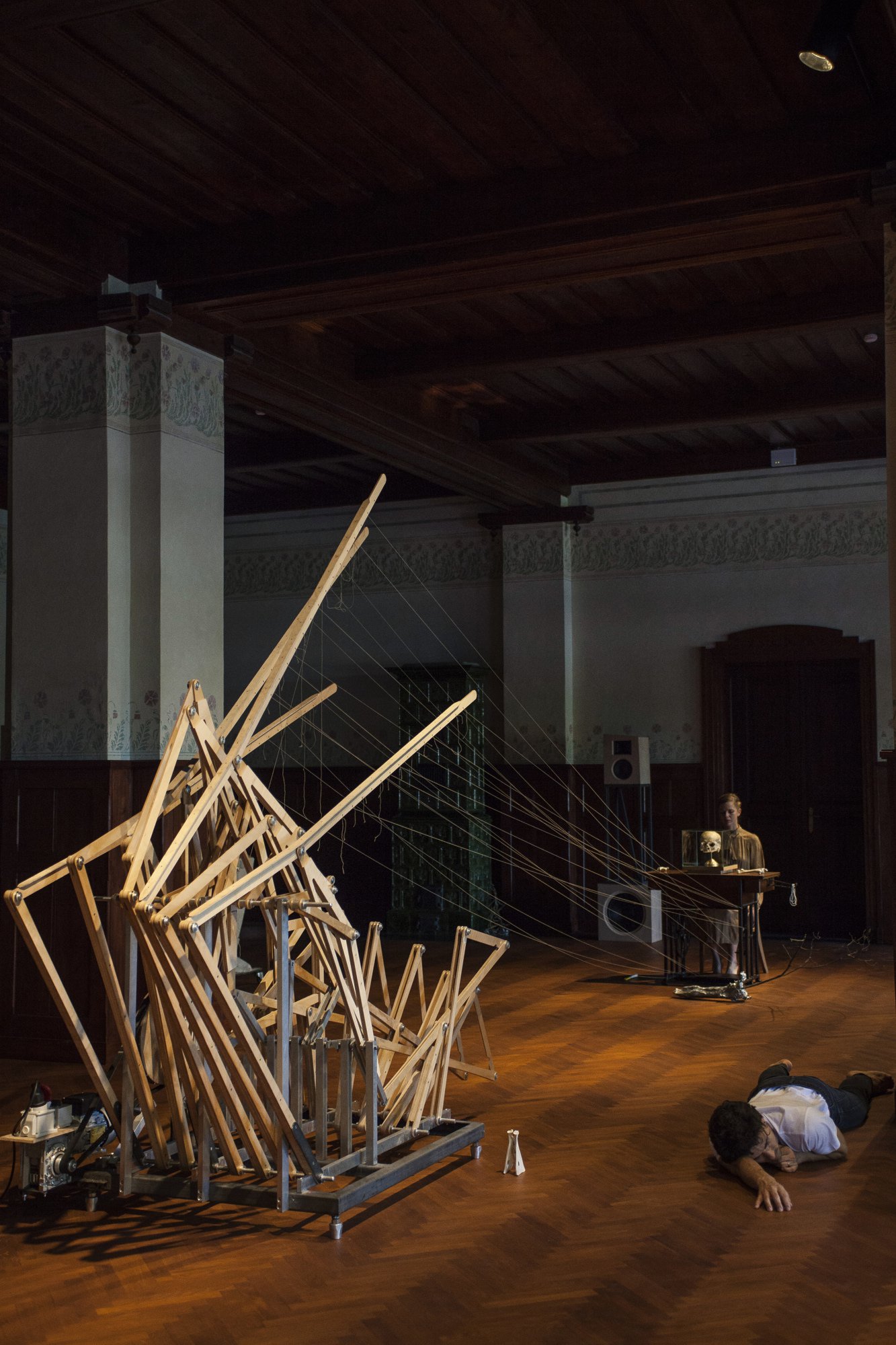
Meta Grgurevič, Silenzio: Eternal Loopholes And Braided Line, 2018, exhibition view Swiss House, Ljubljana, photo: Urška Boljkovac. More about each work, also with the accompanying videos: https://www.meta-kinetics.com/
Meta Grgurevič completed her graduate studies in decoration and her postgraduate studies in painting at the Academy of Fine Arts in Venice in 2007. Why Venice? Having not been accepted to the Academy of Fine Arts and Design and the Faculty of Architecture in Ljubljana (“I don't perform my best under pressure.”),[5] she was introduced to the Accademia di Belle Arti di Venezia by Jasmina Cibic (*1979), a Slovenian artist already attending the academy; Grgurevič seized the opportunity.[6] While still at the academy, between 2002 and 2006, Grgurevič collaborated with Jasmina Cibic, Mara Ambrožič, and Mary Favaretto in the Passaporta Art Collective. Partly inspired by certain projects of the Slovenian NSK/IRWIN Collective, the group addressed the issues surrounding non-spaces, transit spaces. Their performances in public space (for example on a train or at a train station), during which each of the four artists played a specific role, had the visitors undergo a certain bureaucratic process. They were, for example, situated in imaginary waiting rooms or promised imaginary journeys through the clearly directed artistic experience.[7]

Passaporta (Mara Ambrožič, Jasmina Cibic, Mery Favaretto, Meta Grgurevič), Bon Voyage. We give you a free pass to enter the desired destination, 8 October 2005, video, 7:13 min., performance on the train “Casanova – Venice/Ljubljana,” border territory at Pesko (former border crossing Krvavi Potok).
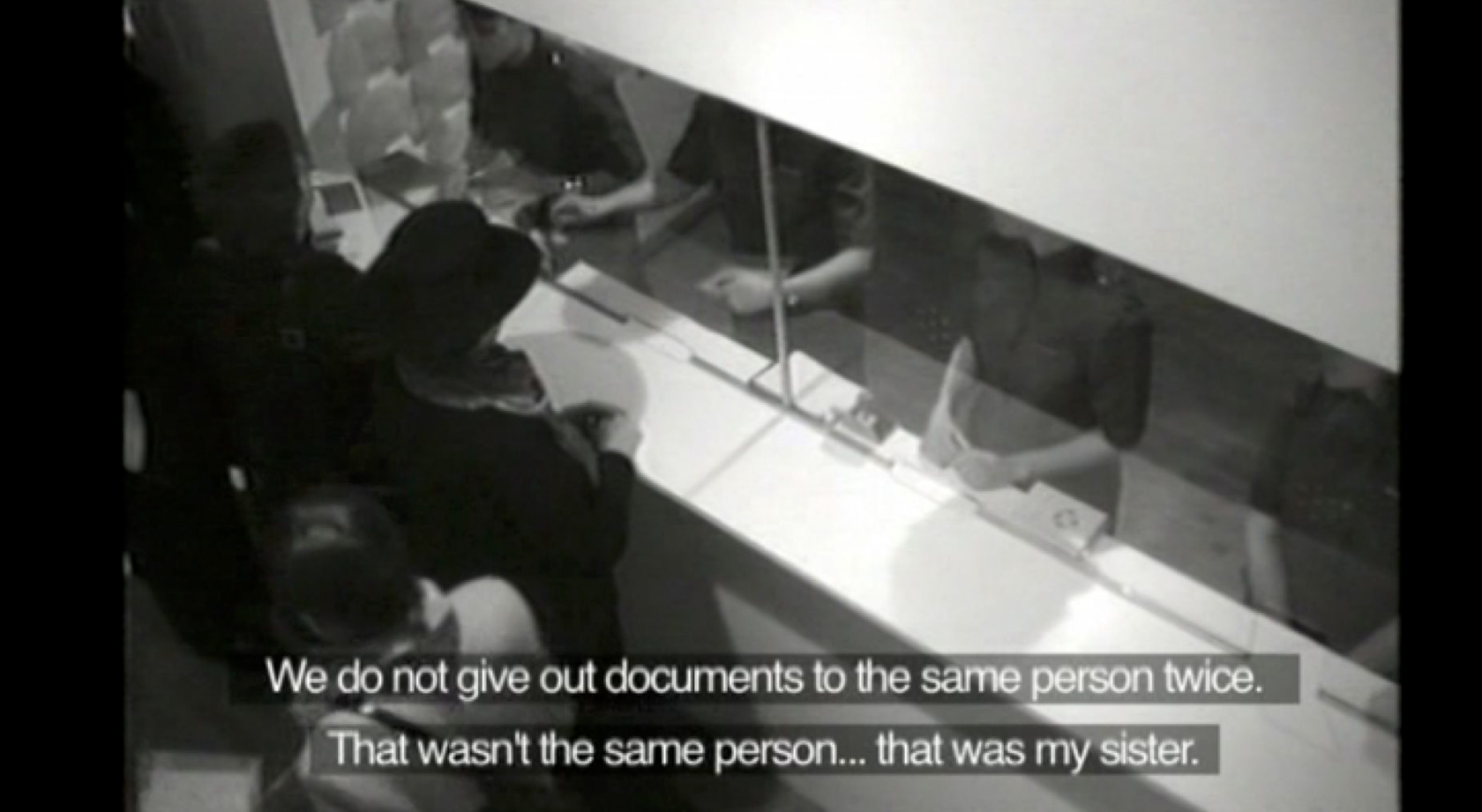
Passaporta (Mara Ambrožič, Jasmina Cibic, Mery Favaretto, Meta Grgurevič), Waiting Room – Station No. II, 27 February 2004, video, 6:32 min., performance in the space of permanent collection, Art Gallery, Sarajevo.
Working as part of a collective influenced the practice of Grgurevič who, following the breakup of the group, began developing independent projects and maintained her tradition of collaborating with different individuals—not always necessarily artists—from various fields. The same is true, for example, of Jasmina Cibic (*1979), who alongside a close-knit group of collaborators (re)creates theatrical stage sets by combining individual elements and different media. Focusing on every detail, her installations are precisely choreographed, sometimes a play with fragmentation on one side or total ambiences on the other, dialogues with the ideologies (its architecture, art, design, and language) of the past.[8] Despite the more personal nature of Grgurevič's work, there is a certain similarity between the practices of both artists; not only in their use of collaboration as method, but also in the skill with which they both make use of, inhabit, and choreograph space, its different elements and the viewer.

Jasmina Cibic, Firm Foundations, 2017, exhibition view at Zak Branicka, Berlin, courtesy Zak Branicka.
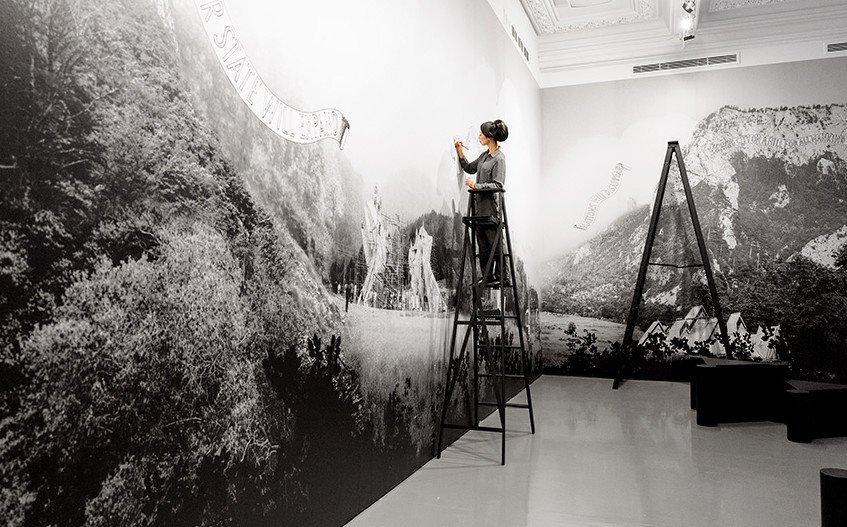
Jasmina Cibic, We will ensure our country does succeed, 2018, installation view at Phi Foundation, photo: Marc Olivier, courtesy the artist and Phi Foundation.
Gesamtkunstwerk – Interdependence and Connectedness
In her practice, Meta Grgurevič blends the tradition of the historical avant-garde and its utopian dreams with her own distinctive, very complex, and technically perfected poetics, thus creating a constant interdependence and connectedness between various elements of her work. Combining video, sound, music, light, performativity, and her kinetic mechanisms, she creates site-specific installations, atmospheric spaces, even environments, that approach the idea of a Gesamtkunstwerk, a total work of art. Her poetics elude categorization into any of the numerous contemporary art trends. However impossible to reduce the subtlety and uniqueness of her artistic language to any one common feature, some prove to be somewhat constant in her art and work: the examination of movement on various levels (on the formal level of the works, which are themselves in movement, or on the level of choreography and the dramaturgy of the work as a whole; the examination of the relationship between the viewer, the artwork, the space); her interest in low-technology, kinetic mechanisms (I call them “sculptures in duration”); a certain feeling of lyricism, poetic sublimity, magic and/or playfulness transmitted by her works, and subtle references to the past and to her own personal history that are capable of inciting each visitor to individual reflection.

Meta Grgurevič's kinetic mechanisms as seen at her exhibition Impossible Machines, UGM Maribor Art Gallery, 2019/20, photo: Damjan Švarc, courtesy The Marignoli di Montecorona Foundation.
Models of Temporality[9]
To paraphrase Groys: the essence of the new is not the revelation of the hidden, it is not a discovery; the new is new in relation to the old, to tradition. Innovation is “to re-evaluate the value of what we have always seen and known.”[10] In her work, Grgurevič also realizes the strategy of the return of certain ideas and works from the history of art. Saying that she is, like the Slovenian IRWIN Collective for example, employing the retro-principle method to reappropriate, recontextualize, and reinterpret the works of historical avant-gardes, would be an incorrect overstatement. However—in a time during which there is a widespread tendency in contemporary art (new-media art/bio art/transgenic art) to draw inspiration from, work closely with, and make use of advanced science, especially digital technologies, to point out the deep commonality of humans with other things, living and non-living—Grgurevič’s work seems somehow anachronistic and archaic, in the best sense of the terms. Grgurevič thematizes the human–non-human relationship not only through dialogue with the present moment, but even more so through the past: the past of certain artistic movements, their ideas and her own personal history. Her low-tech devices and their handmade aesthetic propose new readings of “what we have always seen and known,”[11] and there is, to quote the exhibition’s curator, Simona Vidmar, something “immensely comforting” in this gesture.[12] Grgurevič’s work is not a deconstruction of the form, but its revival through the moment of repetition. In this context, I would like to take a closer look at two of her works, Letatlin (2012/2019) and Galanterie Mécanique (2013).
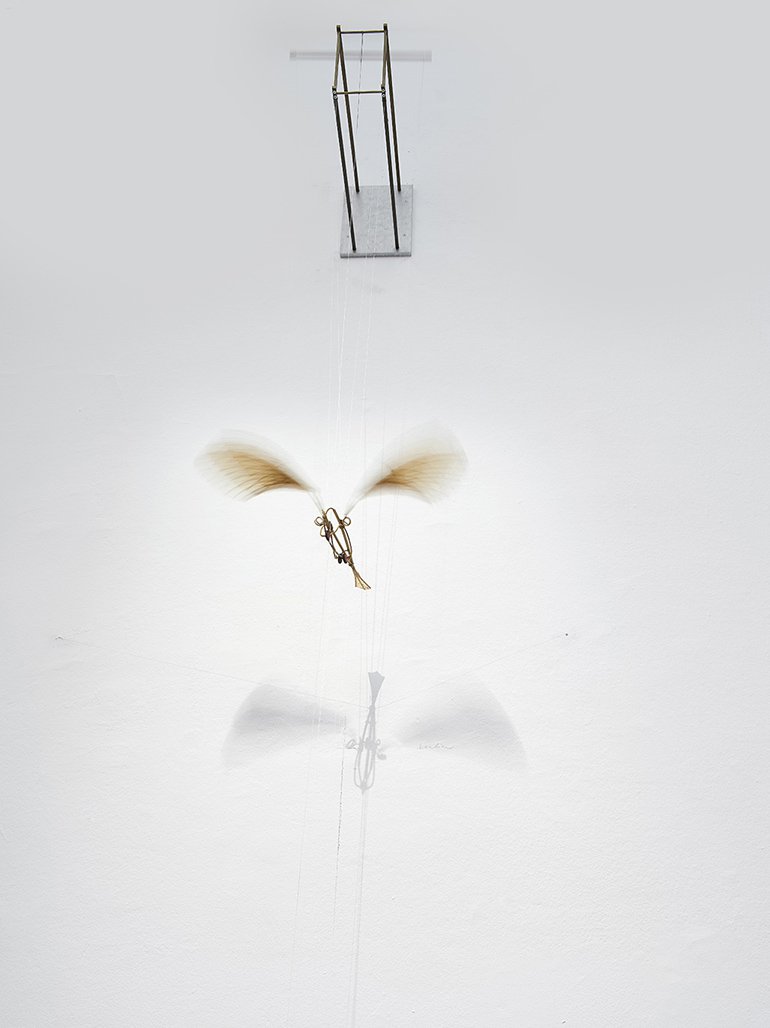
Meta Grgurevič, Letatlin (Lucid Dreams), 2012/2019, exhibition view UGM Maribor Art Gallery, 2019/20, photo: Damjan Švarc, courtesy The Marignoli di Montecorona Foundation.
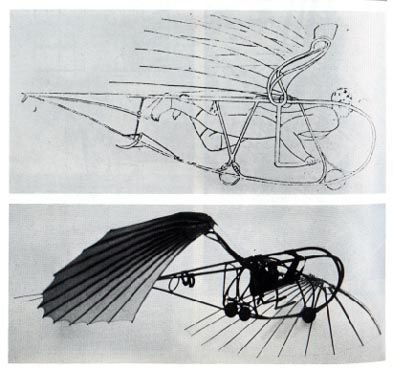
Sketches for Vladimir Tatlin's Letatlin flying machine (1932), (http://acravan.blogspot.com/2010/09/labor-day-vladimir-tatlin-1885-1953.html).
Letatlin (2012/2019) is a kinetic sculpture which is part of Lucid Dreams (2012), a wider series of Grgurevič’s works inspired by Nikola Tesla and Vladimir Tatlin. The Letatlin flying device was devised by Vladimir Tatlin (1885–1953), approximately between 1929 and 1931. Tatlin, one of the main representatives of the Russian avant-garde, designed the plans for the machine after numerous Russian avant-garde artists decided to assume an active role in the construction of the Soviet state (from the beginning of 1920 onwards). However, Tatlin did not wish to build a device that would merely serve man; he also wished to devise a “liberating,” “mystical” experience of flight, that differed from the mechanical sensation in an airplane when “we cannot feel the movement of our own body in the air.”[13] He wrote about this himself: “The dream is as old as Icarus [...] I too want to give back to man the feeling of flight. This we have been robbed of by the mechanical flight of the aeroplane.”[14] The device was never built; it would not have contained an engine but would have instead been powered by the pilot's legs. In Grgurevič’s case, Letatlin is a small kinetic model that flies with the help of threads attached to an old gramophone.[15] Various constructivist projects that were already essentially utopian have become “symbols of a utopian world for which artists have hoped to build it”; models similar to their hopes.[16]
Galanterie Mécanique (2013) is a “symphony of kinetic objects, videos, performance and music, combined in a unified spatial whole, driven by reflections on the relationship between man and machine.”[17] The project's main starting point, in terms of content, was Charlie Chaplin's film Modern Times (1936), which illustrates the capitalist tendency towards mechanization in the name of increased efficiency and profit through a lucid and somewhat romantic critique of the Fordist method of production. The worker becomes analogous to the machine—a passive repetition. In contrast with Chaplin's humorous and critical perspective, the work was also influenced by Vsevolod Meyerhold (1874–1940), a Russian avant-garde theater director, who attempted to create a theater for the new industrial era. He rejected naturalism and text-based plays and promoted movement and gesture as the central means of expression. Actors moved with mechanical precision, exhibiting total control over the body, and in collective synchrony. Galanterie Mécanique is “a contemplation on (…) the collaboration and cooperation between individuals and the position of the individual within wider social relationships”[18]—an ever-present aspect of all her kinetic mechanisms that is also central to the way in which Grgurevič undertakes her artistic practice. As already pointed out, she approaches artmaking as a collaborative effort, working together with, among others, visual artist Jaša, set designer and visual artist Urša Vidic, pianist and composer Bowrain (Tine Grgurevič), and France Petač, the craftsman in charge of constructing most of the low-tech mechanisms. “Through the years of making art, I have begun to understand the definition of a fully functioning system as a metaphor for my own system in relation to and bearing responsibility toward the social environment.”[19] Grgurevič likens her role to that of a director, “but more so in the sense that I am responsible for making an art project happen at all: from the moment I invite people to participate until the final realization of the idea, taking into consideration also the fact that [their] work is properly paid, signed, and recognized. My work ethic has always been very important to me.”[20]
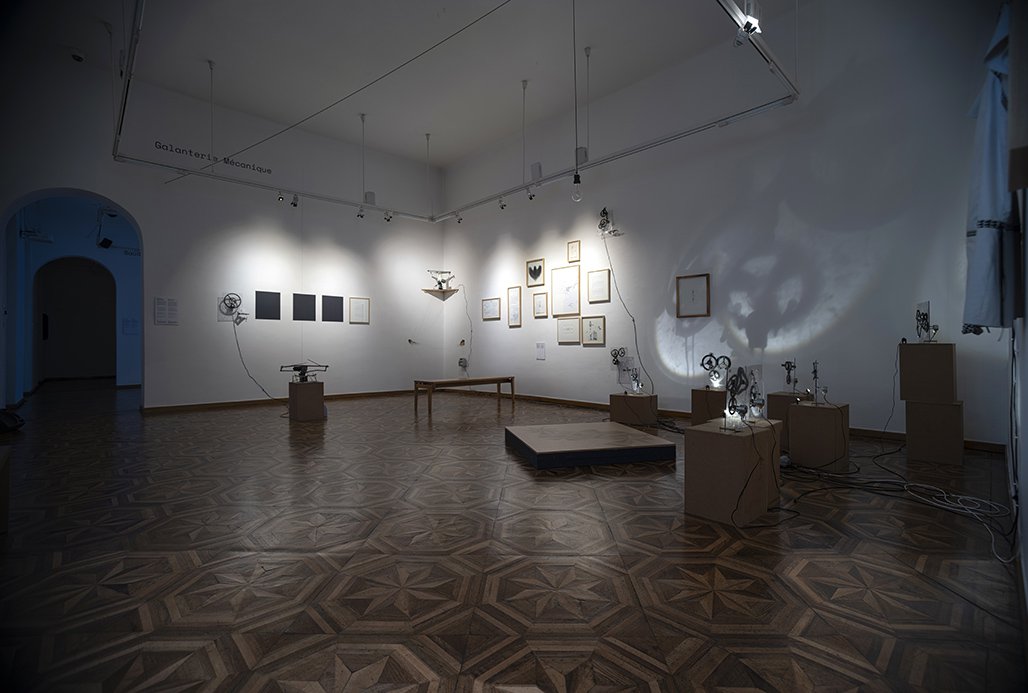
Meta Grgurevič, Galanterie Mécanique, 2013/2019, exhibition view UGM Maribor Art Gallery, 2019/20, photo: Damjan Švarc, courtesy The Marignoli di Montecorona Foundation.

Meta Grgurevič, Galanterie Mécanique (performance at the opening), 2019, UGM Maribor Art Gallery, photo: Sara Rezar.
Time and the question of different temporalities are important elements of Grgurevič’s artistic practice from the point of view of both form and content. This is exemplified in many of her clock-like mechanism, e.g. Saudade_Clock Mechanisms (2013), a series of kinetic mechanisms which do not function as time-measuring tools but are, rather, transformed into musical instruments, their unique punctuation, not unlike a metronome, demonstrating our relativized awareness of time; or TIMEKEEPERS (2015), which magically plays with an hourglass, the laws of physics (time, gravity, light) and the infinity symbol; as well as the aforementioned Galanterie Mécanique (2013), which in the video also introduces the object of the metronome.
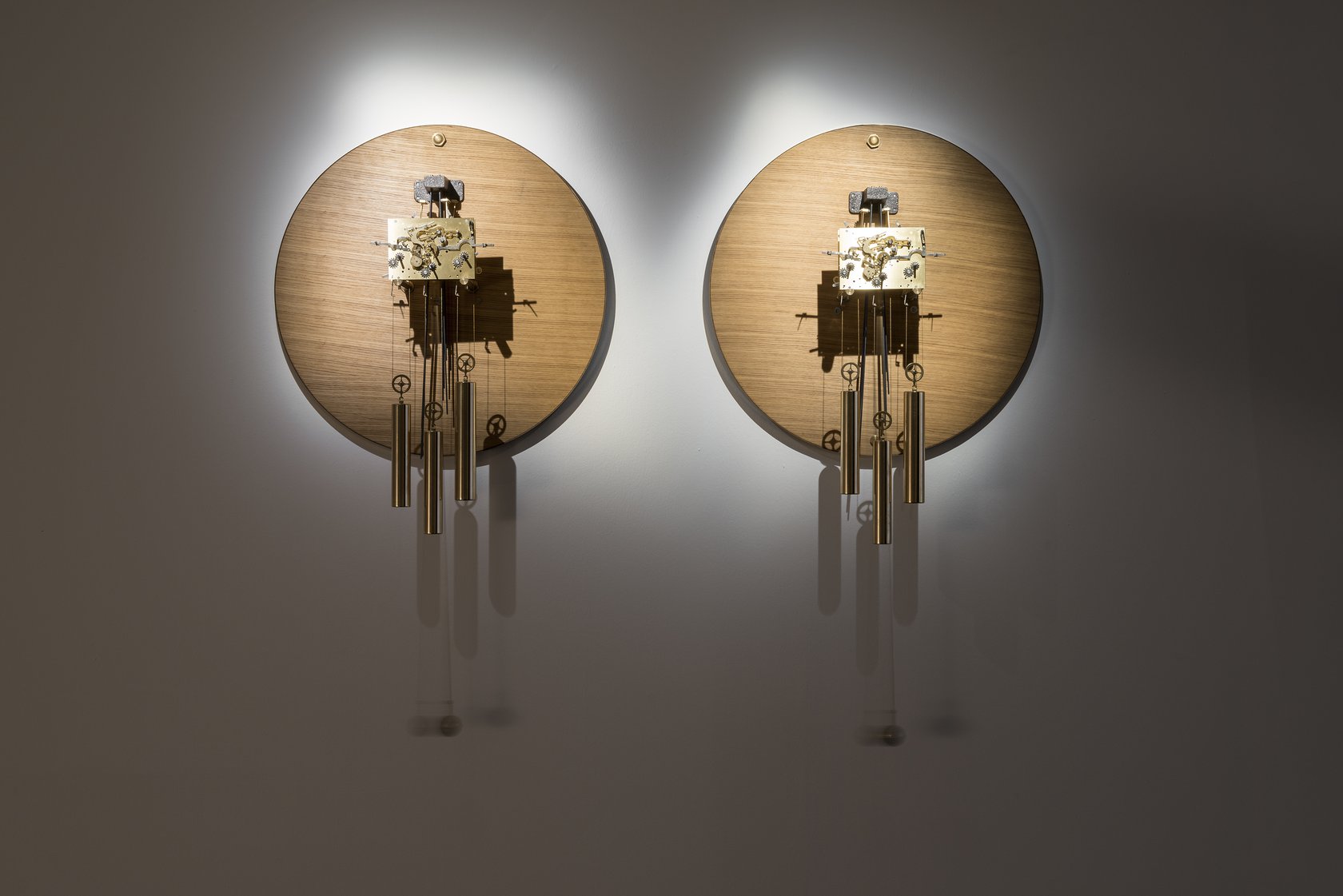
Meta Grgurevič, Saudade_Clock Mechanisms, 2013, exhibition view Künstlerhaus, Halle für Kunst & Medien, 2020, photo: Markus Krottendorfer.

Meta Grgurevič, Timekeepers, 2015, exhibition view UGM Maribor Art Gallery, 2019/20, photo: Damjan Švarc, courtesy The Marignoli di Montecorona Foundation.
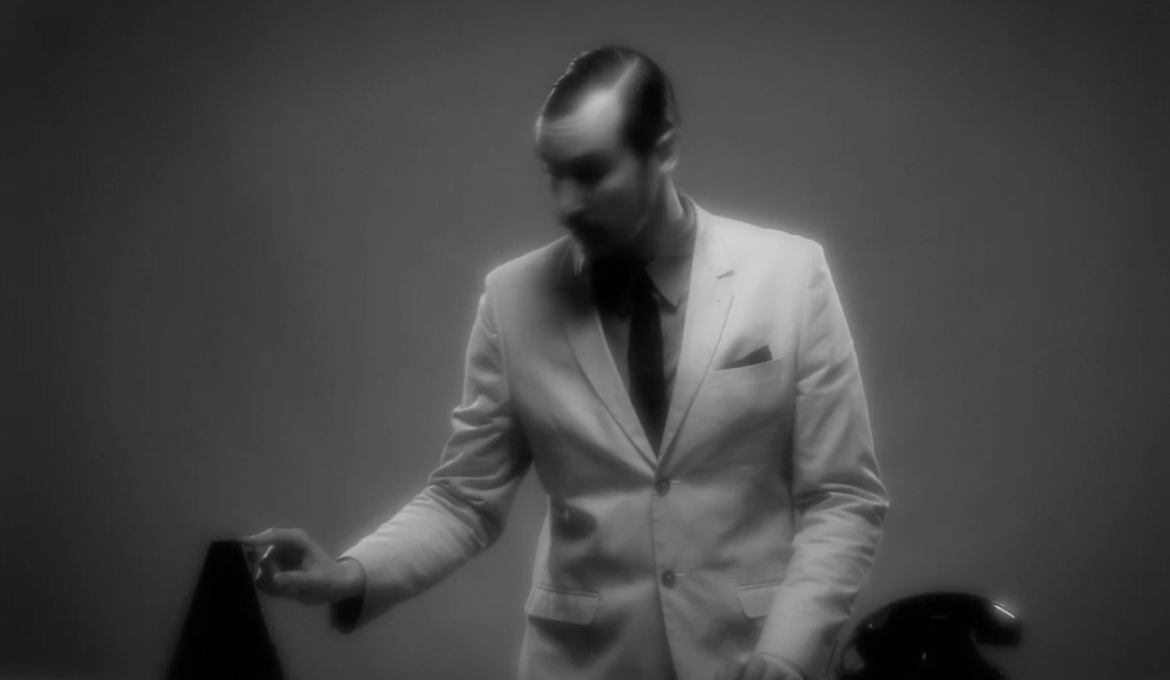
Meta Grgurevič, Galanterie Mécanique (still from video with JAŠA), 14:59 min, 2015.
Apart from these works, which directly reference time, two other works should be highlighted as well: the first, Untitled (2013), is on display at UGM Maribor Art Gallery (as part of the Galanterie Mécanique installation), and the second, STATE OF RETURN_situation 3 (2019/20), is on display at Künstlerhaus, Halle für Kunst & Medien. Both are not merely sculptures in movement, but sculptures in duration. They are changing and de-construction themselves and/or its surroundings through time. The untitled piece, positioned in the corner of the room, repeatedly hits two sides of the wall in precisely measured intervals. Less destructive, at least at first glance, is STATE OF RETURN_situation 3, in which a knitted garment is—almost undetectably, throughout the duration of the exhibition, steadily—unstitched by a machine. As though a contemporary Sisyphus had entered the gallery space; better yet, a modern Penelope, who had been waiting twenty long years for Odysseus' return, sewing and unstitching his funeral shroud to stave of suitors and see his return… What or who are Grgurevič’s sculptures waiting for?
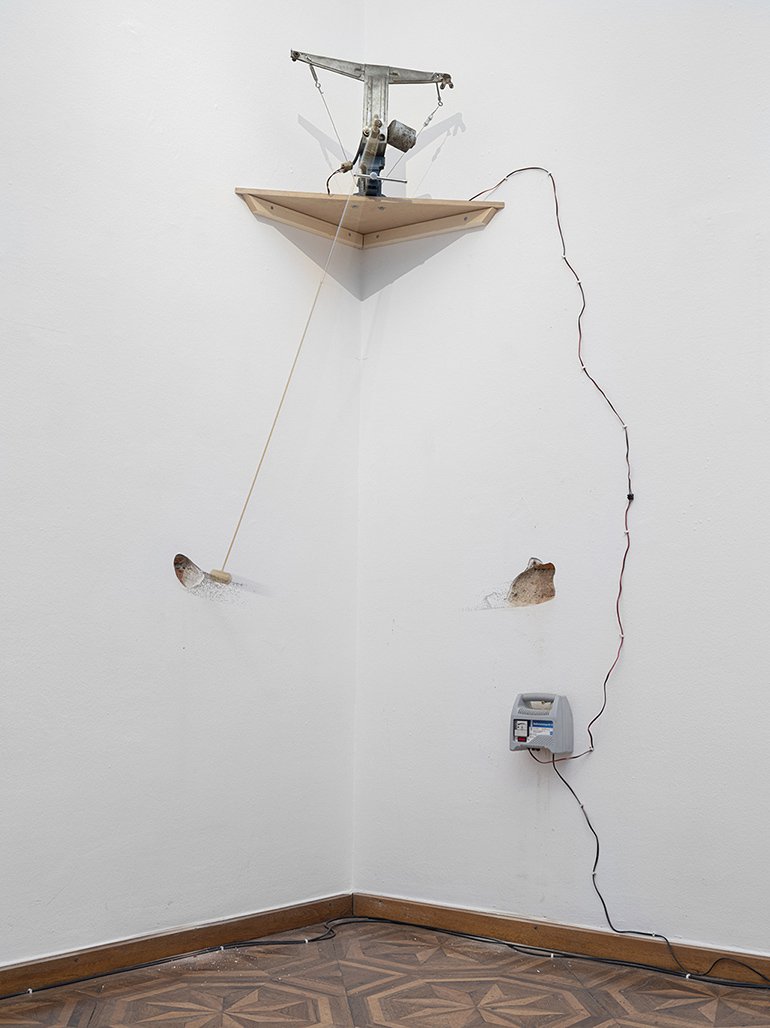
Meta Grgurevič, Untitled (as part of the Galanterie Mécanique installation), 2013, exhibition view UGM Maribor Art Gallery, 2019/20, photo: Damjan Švarc, courtesy The Marignoli di Montecorona Foundation.

Meta Grgurevič, STATE OF RETURN_situation 3 (detail), 2019/2020, exhibition view Künstlerhaus, Halle für Kunst & Medien, 2020, photo: Markus Krottendorfer.
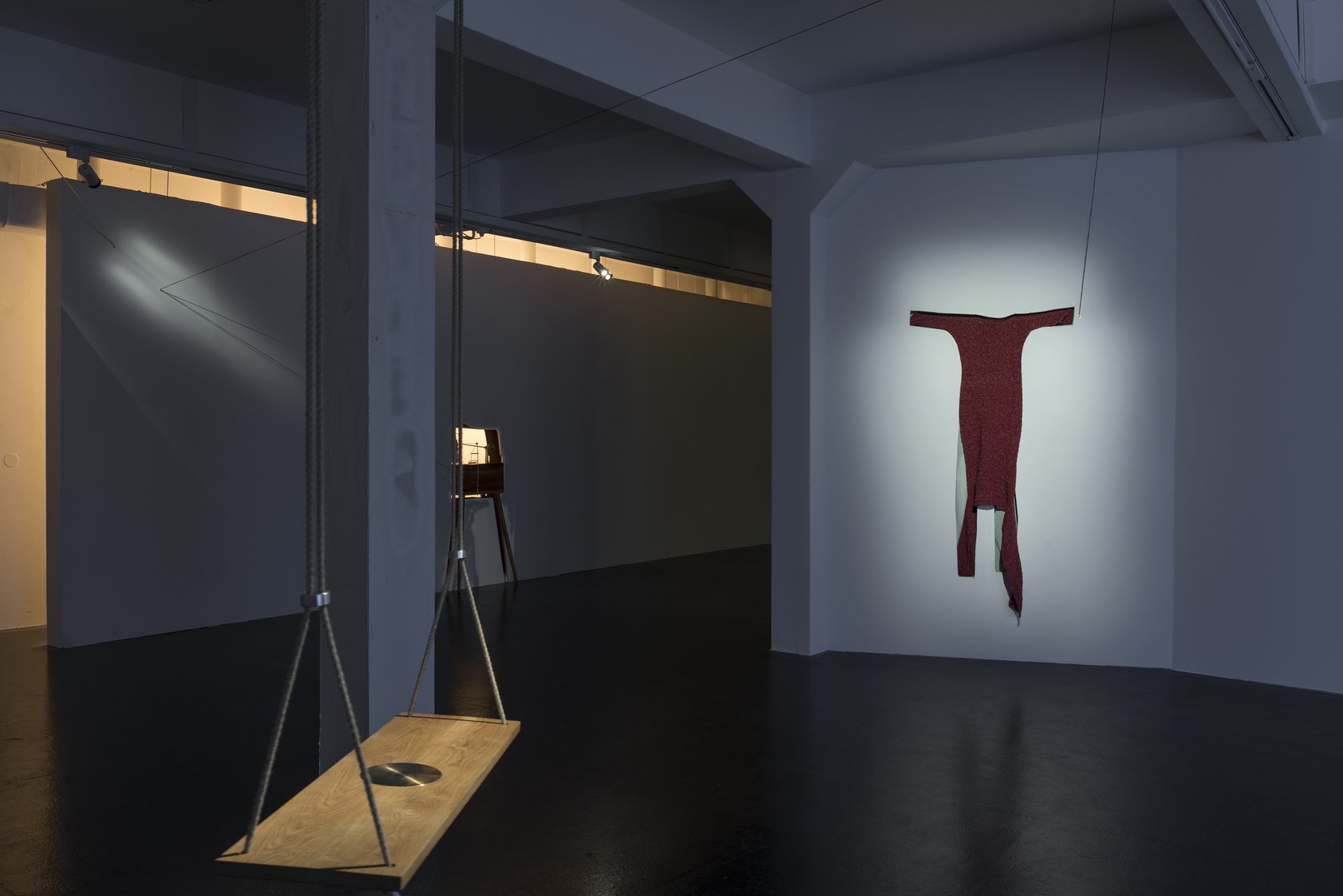
Meta Grgurevič, STATE OF RETURN_situation 3 (detail), 2019/2020, exhibition view Künstlerhaus, Halle für Kunst & Medien, 2020, photo: Markus Krottendorfer.
Poetic Poetics of Tension
When we engage with Grgurevič’s scupltures in duration we find ourselves in a somewhat intermediate state of tension that is difficult to verbalize; these are intermediate, transient states, states of waiting, perhaps even of being trapped. Quite often, they trigger conditions that appear to be (at least superficially) completely nonsensical—much like the artist's machines, which are perfectly functional, yet completely impractical, some even simultaneously destructive.
Grgurevič’s work can be therefore defined as an extremely poetic poetics of tension. It would seem that one of the predominating themes of her work is finding balance: not only between the material and the ephemeral, the visual and the non-visual, the old and the new, but also between past and future, here and there, emerging and becoming, the spoken and the unspoken, the individual and the collective, between dreams, memories, and reality.
In lieu of a conclusion, I would like to discuss a video that was featured in the exhibition mentioned in the introductory paragraph that I attended five years ago and that somehow still resonates with me. The video Saudade (2015) shows a mother and daughter (Meta and Bella), at once together and alone, sitting on a chair, suspended between falling and floating—the movement, the change, as in the unstitching piece STATE OF RETURN_situation 3, (2019/20), is barely visible. “Saudade,” a Portuguese word, has no direct translation in English; it describes a profound longing for something that is impossible to define: a yearning for something other than the present, looking back at the past and at the same time turning towards the future. I am always in the present and still in the past, and already in the future. I am always here and also elsewhere.
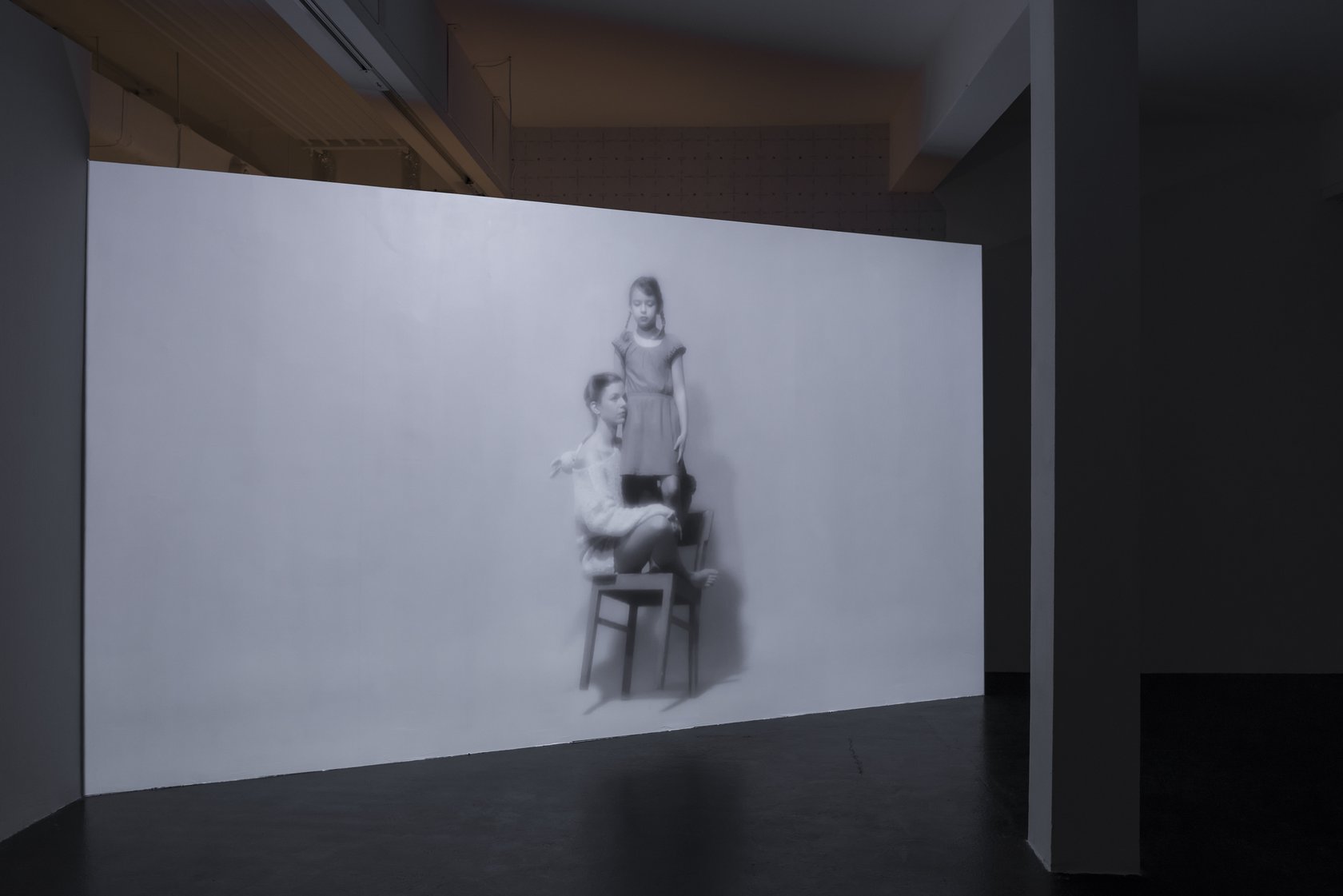
Meta Grgurevič, Saudade, 2015, exhibition view Künstlerhaus, Halle für Kunst & Medien, 2020, photo: Markus Krottendorfer.
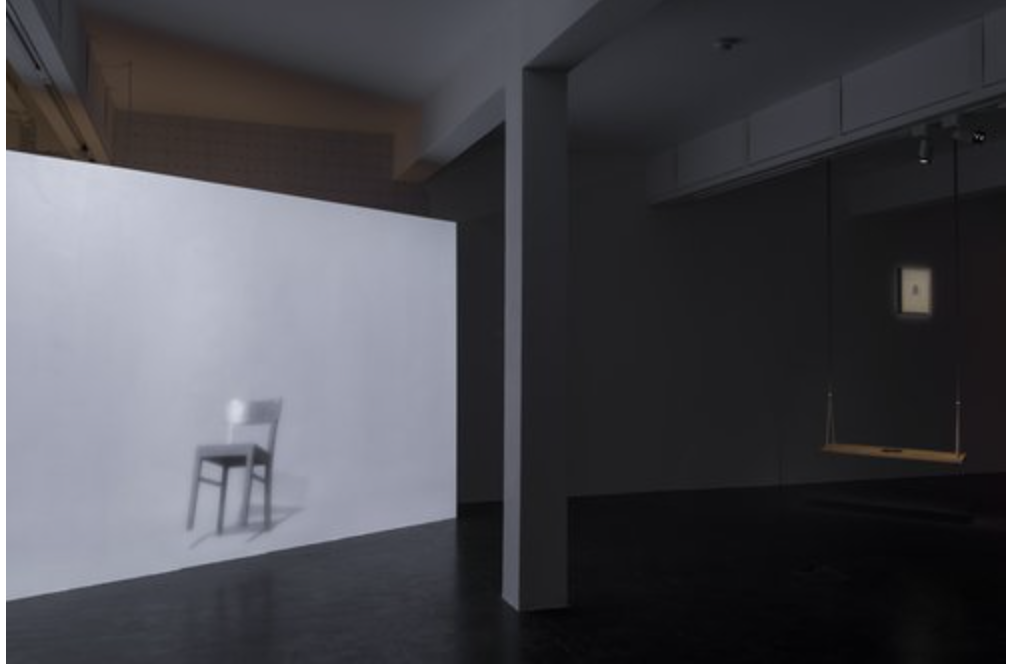
Meta Grgurevič, Saudade, 2015, exhibition view Künstlerhaus, Halle für Kunst & Medien, 2020, photo: Markus Krottendorfer.
It is certainly noteworthy to draw one final parallel between the work of Meta Grgurevič and Vadim Fiškin (1965, Penza, USSR), an artist born in the now Russian federation, but living and working in Ljubljana, Slovenia, whose art scene he definitely influenced.[21] Fiškin's work is intimately linked to technology and current scientific developments, “[h]owever, any interest in technology and science is less a direct result of engagement in these domains themselves and more a by-product of what they can tell us about ourselves and such perennial issues as the search for faith and meaning, and the sense of futility known to reward such human enterprises.”[22] A certain magic exuded by Grgurevič's work also emanates from Fiškin's exceptional and unique artistic practice.
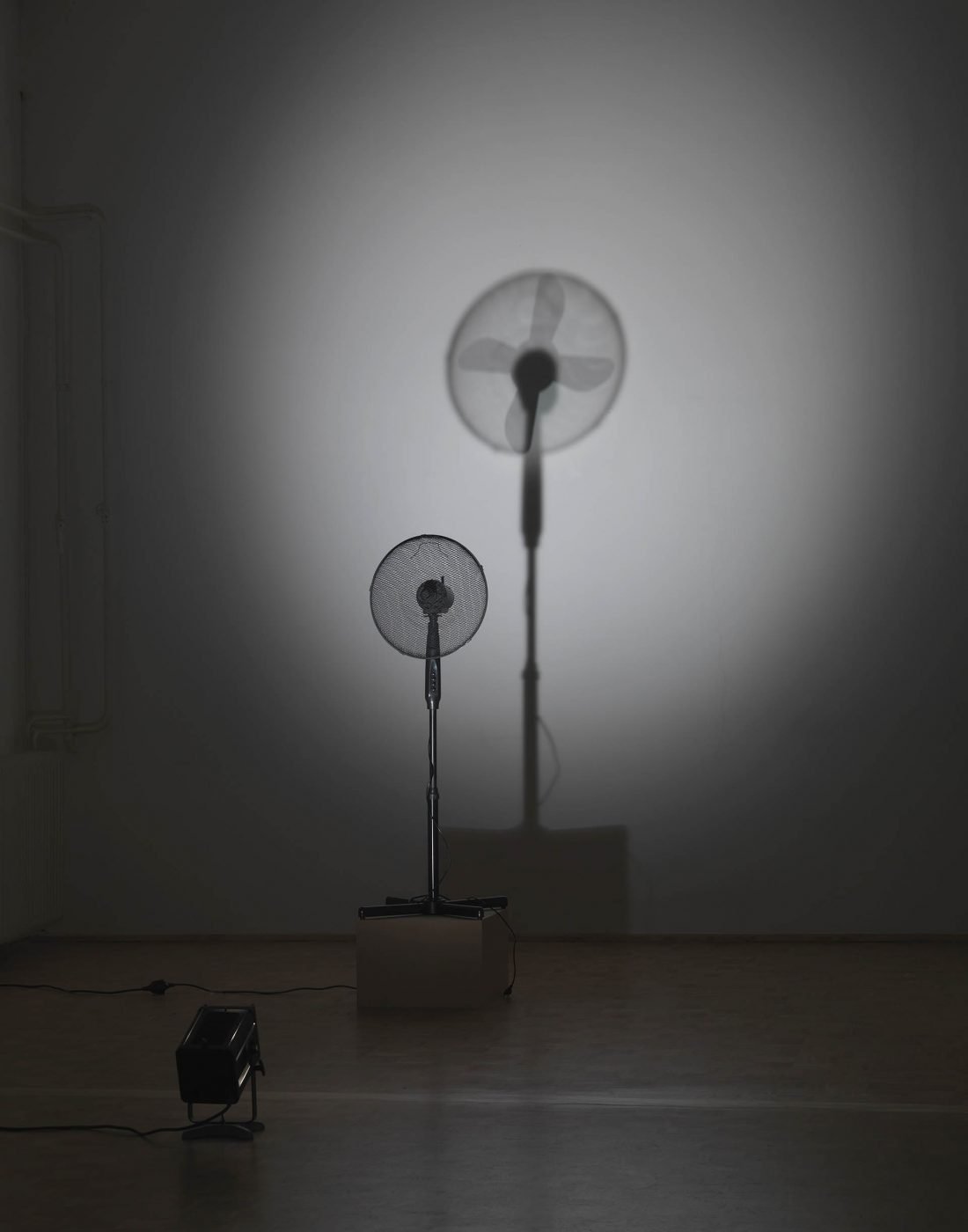
Vadim Fishkin, Missing Part, 2016, photo: Jaka Babnik.
Lastly, I believe the appropriate way of concluding this text is with a thought by Donald Knuspit because it resonates with Grgurevič's work in a certain way. Her art is, I quote, “neither traditional nor avant-garde, but a combination of the two. It brings together the spirituality and the humanism of the Old masters and the innovation and criticality of the Modern masters. It is New Old Master.”[23]
It is refreshing, in the cyberage of aesthetic beyond aesthetic and many highly political artistic projects, to also experience art which is intentionally sensuous and opens up a subtle, intimate space for the search of meaning.
Hana Ostan Ožbolt MA (*1991 Ljubljana, lives in Ljubljana) is a freelance curator and directress of the ULAY Foundation based between Ljubljana and Amsterdam. She obtained her Master’s degree in Art History from the Faculty of Arts in Ljubljana and completed the School for Curators and Critics of Contemporary Art, “World of Art” (2014–16). In recent years, she has worked in the field of contemporary art (the private galleries and the NGO sector) in Ljubljana and Berlin, among others, for Aksioma – Institute for Contemporary Art and Galerija Gregor Podnar. She was also the initiator of HOoST, a framework aimed at supporting and promoting emerging artists while organizing their exhibitions outside the institutional frame. She has curated, co-curated and collaborated on numerous exhibitions of various artists in Škuc Gallery, Museum of Contemporary Art Metelkova, DLUL Ljubljana, DUM Project Space and Goethe Institute.
Footnotes:
[1] Boris Groys, “Under the Gaze of Theory,” in In the Flow (London, New York, 2016), pp. 23–42.
[2] Boris Groys, “Under the Gaze of Theory,” in In the Flow (London, New York, 2016), pp. 23–42.
[3] Boris Groys, “Under the Gaze of Theory,” in In the Flow (London, New York, 2016), pp. 23–42.
[4] “However, theory was never so central for art as it is now. So the question arises: Why is this the case? I would suggest that today artists need a theory to explain what they are doing—not to others, but to themselves. In this respect they are not alone. Every contemporary subject constantly asks these two questions: What has to be done? And even more importantly: How can I explain to myself what I am already doing? The urgency of these questions results from the acute collapse of tradition that we experience today. Let us again take art as an example. In earlier times, to make art meant to practice—in ever-modified form—what previous generations of artists had done. During modernity to make art meant to protest against what these previous generations did. But in both cases it was more or less clear what that tradition looked like—and, accordingly, what form a protest against this tradition could take. Today, we are confronted with thousands of traditions floating around the globe—and with thousands of different forms of protest against them. Thus, if somebody now wants to become an artist and to make art, it is not immediately clear to him or her what art actually is, and what the artist is supposed to do. In order to start making art, one needs a theory that explains what art is. And such a theory gives an artist the possibility to universalize, globalize their art. A recourse to theory liberates artists from their cultural identities—from the danger that their art would be perceived only as a local curiosity. Theory opens a perspective for art to become universal. That is the main reason for the rise of theory in our globalized world. Here the theory—the theoretical, explanatory discourse—precedes art instead of coming after art." Boris Groys, “Under the Gaze of Theory,” in In the Flow (London, New York, 2016), pp. 23.
[5] Interview with Meta Grgurevič, Ljubljana, February 5, 2019.
[6] It is interesting to point out the generation of Slovenian artists born around the year 1980, who all graduated at the Academy of Fine Arts in Venice, are today present in the local, as well as (or even more so!) in the international art scene. Apart from Jasmina Cibic (*1979), who represented Slovenia at the 55th Venice Biennale (2013), we should also mention Jaša (*1978), who representetd the country at the 56th Venice Biennale (2015), and Ištvan Išt Huzjan (*1981).
[7] Passaporta (Mara Ambrožič, Jasmina Cibic, Mary Favaretto, Meta Grgurevič), Waiting Room — Station No. II, 27 February 2004 (performance in the space of permanent collection, Art Gallery, Sarajevo); Bon Voyage. We give you a free pass to enter the desired destination, 8 October 2005 (performance on the train “Casanova−Venice/Ljubljana”, border territory at Pesko); PP Officers, 14. February 2006 (performance at the train station Venezia Santa Lucia, Venice). More: http://www.mg-lj.si/en/exhibitions/1356/2005-2015-passaporta/ (accessed February 27, 2020).
[8] Jasmina Cibic’s video installation The Gift, Act I (2019), the first chapter of her new poetic study of the many political gifts found in European history of art and architecture, was just recently on view at Künstlerhaus, Halle für Kunst & Medien, as part of the steirischer herbst 2019 (20 September−28 November 2019).
[9] The title is taken from the short text “Models of Temporality” that the curator Alenka Trebušak wrote for the Saudade exhibition at the Tobačna 00 Cultural Centre in Ljubljana in 2013.
[10] Boris Groys, Teorija sodobne umetnosti [On the New] (Ljubljana, 2002), pp. 11–22.
[11] Boris Groys, Teorija sodobne umetnosti [On the New] (Ljubljana, 2002), pp. 11–22.
[12] “Meta's machines are also immensely comforting, reminding us of something we have always known and reassuring us that the world around us is the way we think it is. Which, of course, is pure utopia.” Simona Vidmar, Meta Grgurevič. Impossible Machines (accompanying text), UGM Maribor Art Gallery / Künstlerhaus, Halle für Kunst & Medien, Graz, 2019/2020.
[13] Christina Lodder, Russian Constructivism (Connecticut, 1983), pp. 213–214.
[14] Lodder 1983 (see note 11), p. 213–214.
[15] It would also be interesting to draw a comparison to the artistic language of Luka Savić (1990), a Slovenian artist of the younger generation, in this case specially to his work Letatlin and Revolution (2015). Letatlin and Revolution is a reconstruction of the mentioned Tatlin’s device in the ratio of 1:2— with the difference that Savić places it on the ground and turns it on its back. He binds it to a mechanical pulley, which eases every couple of seconds; the wings of the device lift from the ground, for a moment maintain their balance, then immediately hit the ground. Thunderous sound of repeating the same movement indefinitely resounds in the space in intervals—a perpetual insistence despite the incapacity (to take off). Savić's reinterpretation also plays with the semantics of the word revolution, which is now completely semantically emptied due to the excessive (all-encompassing) use; it has lost its historical and political meaning. Revolūtiō (Lat.) means “reversal,” “turn,” “circulation”; it is a derivative from Lat. revolvere, which is translated as “rotate,” “reverse,” “twist,” or originally “roll back.” The work thus cannot be read merely as a commentary on the then unsuccessful October Revolution of 1917, but primarily as an interpretation, closer to the author's idea: revolution is always repeating itself in its failure.
[16] Aleš Erjavec, Heteronomija umetnosti in avantgard (Ljubljana, 2017), pp. 27, 34.
[17] Meta Grgurevič. Impossible Machines (accompanying text), UGM Maribor Art Gallery, 2019/2020
[18] Meta Grgurevič. Impossible Machines (accompanying text), UGM Maribor Art Gallery, 2019/2020
[19] Meta Grgurevič. Impossible Machines (accompanying text), UGM Maribor Art Gallery / Künstlerhaus, 2019/2020.
[20] Interview with Meta Grgurevič, Ljubljana, February 5, 2019.
[21] Fiškin represented Slovenia at the Venice Biennale in 2005. More on Fiškin's work: http://www.vadimfishkin.si (accessed February 26, 2020).
[22] “Vadim Fishkin,” www.gregorpodnar.com http://gregorpodnar.com/vadim-fiskin (accessed February 26, 2020).
[23] Donald Kuspit, The End of Art (New York, 2004), pp. 182–183.
In The End of Art, Donald Kuspit argues that art is over because it has lost its aesthetic import. Art has been replaced by postart, a term invented by Alan Kaprow, as a new visual category that elevates the banal over the enigmatic, the scatological over the sacred, cleverness over creativity. Even if I do not agree with Kuspit’s theory as a whole, which can seem anachronistic from today’s point of view, there is a certain relation to what has just been discussed. In reaction to the “emptiness” and “stagnancy” of postart, Kuspit signals the “aesthetic” and “human future” that lies with the New Old Masters.
Bibliography:
Dobnikar, Žiga. "Galanterie Mécanique." In Resilience. U3–7th Triennial of Contemporary Art in Slovenia, edited by Nataša Petrešin-Bachelez, exh. cat. Museum of Contemporary Art, Metelkova. Ljubljana, 2013.
Erjavec, Aleš. Heteronomija umetnosti in avantgard. Ljubljana, 2017.
Feng, Peng. "Aesthetics and Contemporary Art: An Experiment in Venice, Aesthetics in Action." In International Yearbook of Aesthetics, edited by Krystyna Wilkoszewska, Volume 18, International Association for Aesthetics, 2014.
Meta Grgurevič. Impossible Machines (accompanying text), UGM Maribor Art Gallery / Künstlerhaus, Halle für Kunst & Medien, Graz, 2019/2020.
Groys, Boris. “Under the Gaze of Theory.” In In the Flow, London & New York, 2016.
Groys, Boris. On the New. London & New York, 2014.
Kac, Eduardo. "Bio Art." In Vivo Aesthetics, Aesthetics in Action, International Yearbook of Aesthetics, edited by Krystyna Wilkoszewska, Volume 18, International Association for Aesthetics, 2014.
Kuspit, Donald. The End of Art. New York, 2004.
Lodder, Christina. Russian Constructivism. Connecticut, 1983.
Logar, Tevž. "Intersection." In Meta Grgurevič. Intersection, edited by Mateja Poljšak-Furlan, exh. cat. Nova Gorica City Gallery, 2015.
Ostan Ožbolt, Hana. Luka Savić. Wunderblock (accompanying text), Gallery DLUL, Ljubljana, 2018.
Pevec, Iza. "Returning to the Sound." In Meta Grgurevič. Saudade, exh. cat. Tobačna 001 Cultural Centre, Ljubljana, 2015.
Trebušak, Alenka. "Models of Temporality." In Meta Grgurevič. Saudade, exh. cat. Tobačna 001 Cultural Centre, Ljubljana, 2015.
Welsch, Wolfgang. "Aesthetics beyond Aesthetics. Aesthetics in Action." In International Yearbook of Aesthetics edited by Krystyna Wilkoszewska, Volume 18, International Association for Aesthetics, 2014.
